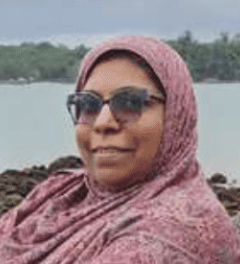Research Objectives:
The study is on Allelopathic Potential of Tramindus indica L. on morphological parameters and Biochemical Components of Black gram (Vigna mungo (L.) HEPPER).
Keywords:
Allelopathic Potential, Germination study, leaf leachates, leaf extracts, morphological parameters, Biochemical components, black gram, Tamarindus tree.
Bio
Dr. G.A. Asif Jamal, M.Sc., M.Phil., Ph.D., FNSF, is an Associate Professor in the Department of Botany at Justice Basheer Ahmed Sayeed College for Women (Autonomous), Chennai, Tamil Nadu, India. With 20 years of teaching experience, she is a Guinness World Record holder for contributing to the world’s thickest book. Dr. Jamal is also an ISO Internal Auditor, IPR specialist, and Certificate Course Coordinator. She has completed various certificate courses in health, plant physiology, and biotechnology. An Environment Management and Energy Audit Lead Auditor, she holds five collaborative patents, has authored six books, published ten research papers, and guided nine undergraduate projects. Dr. Jamal has presented numerous research papers internationally, earning multiple awards and honours.
The current investigation is on Allelopathy which is ecologically important because it influences dominance. Productivity, succession. Species diversity, composition of plant communities and vegetation dynamics, the acquired knowledge of allelopathy helps in Explaining vegetation patterns in plant communities. The study is on Allelopathic Potential of Tramindus indica L. on morphological parameters and Biochemical Components of Black gram (Vigna mungo (L.) HEPPER). Various concentrations of leaf latches and leaf extracts were prepared respectively from fully senesced fallen leaves and fully matured leaves of Tamarindus tree for the experiment.
In the germination study, healthy and uniform seeds of vigna mungo selected and experiments were conducted by the application various concentrations of leaf leachates and leaf extracts to the seeds length and germination study and were dramatically decreased with increasing the concentrations of leaf extract. The leaf extract had more inhibitory effect than the leaf leachates on germination and morphological parameters and Biochemical components of black gram. From this investigation it clearly showed Tamarinbus indica had strong allelopathic effects on germination, growth and Biochemical components of black gram vigna mungo.
Introduction
Hans Molish (1937), Emeritus professor of plant physiology at the university of Vienna, coined the word ‘Allelopathy’ from Greek words ‘allelon’, meaning ‘mutual’ and pathos, meaning harm to describe the effects that one plant could have on another due to released chemicals. Allelopathy has received increased attention Over the last 40 years with studies on effect of weed interference on crop yields, allelopathic effects of crop plants on other crop plants, crop plants on weeds and allelopathic effects of woody seed plants on crop plant in forestry and Horticultural fields. The present study was carried out to ‘investigate the allelopathic effect of Tamarindus indica L. leaf leachates and leaf extracts on seed germination and seedling growth of black gram (Vigna mungo Hepper,).
Objectives of the Study
- Vegetation pattern in Plant Communities
- To understand the mechanism of action of Allelochemicals inhibiting the uptake of nutrients Introduction
- To study the morphological and biochemical parameters with effect of leaf leatchates and leaf extracts
- Seed germination and Seedling Growth of Vigna mungo
Materials and Methods
Seeds of Vigna mungo L. were procured from Regional Pulse Research Station vamban, Pudukottai District, Tamil Nadu. The fully matured senesced fallen leaves of Tamarindus indica L. were collected from Annamalai University campus, Annammalai nagar.
Preparation of leaf leatchates
The Preparation of leaf leatchates and dried fresh leaf extracts and germination studies were followed as per the methods of Padhy et al., (2000).
20 grms of fallen leaves were collected from Tamarindus indica L., tree. They were washed in tap water thoroughly followed by tap water and were later soaked in 100 ml of distilled water for 48 hours, later the leaves were filtered, and the filtered water is known as leaf leatchates and were considered as 20% concentration.
Preparation of Dried leaf extracts
The collected Tamrinduss indica were air dried, ground to a fine powdered and extracted in water, where in 25 grms of Tamrinduss indica leaf powder was soaked in 1 litre of distilled water kept for 48 hours at Room temperature with occasional shaking.
Germination Study
The selected seeds of vigna mungo were surface sterilized with 0.03% formalin solution for 20 minutes and then washed thoroughly with distilled water.
In the germination study, 25 seeds were placed sterilised petiolate lined with two layered filter paper, 10 ml of leaf leachates and leaf extracts was added per treatment to the seeds on the petri plates. Distilled water served as a control. The process was continued for 15 days. Later the seeds were allowed to germinate in a growth chamber and kept in light intensity of 2+- 0.4 K Lux and at 30+-2◦C till 15 days. Each treatment was repeated in triplets. The number of seeds germinated were counted regularly each day and germinating percentage was calculated. The morphological parameters were studied on the root and shoot length from 8th and 15th day after sowing. The infusion was decanted and filtered through 3 layers of Whatman No 1 filter paper.
The concentrations of leaf leachates and leaf extracts were prepared with dilutions such as 5%, 10% ,15% and 20% was the standard solution, with distilled water were prepared respectively from fully senesced fallen leaves of Tamarindus tree for the experiment.
The Germination Percentage refers to the appearance of the radical by visual observation. It was calculated using the formula, the formula was given by Carley and Watson (1968).
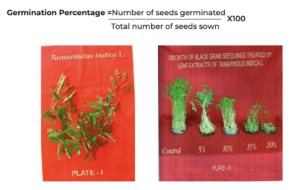
Biochemical Analysis
The fresh material as used for the estimation of Chlorophyll, Sugar, Free Amino Acids and Proteins.
Observations and Results
The study showed a dramatically decreased with increasing the concentrations of leaf extract.
The leaf extract had more inhibitory effect than the leaf leachates on germination and morphological parameters of black gram.
Form this investigation it clearly showed Tamarinbus indica had strong allelopathic effects on germination and growth of black gram vigna mungo.
Allelopathy depends on chemical compounds mainly added to the environment from living plants or dead and decaying plant parts (Tukey, 1969) Allelochemicals also refers to the secondary metabolites produced by plants and are the byproducts of primary metabolic process and they have no physical function essential for the maintenance of life (Levin,1976).
Bio-chemical Analysis for Chlorophyll, (mg/gfr.wt) the changes in Chlorophyll-a and Chlorophyll –b total Chlorophyll content under leaf leachates treatment is given in table -3.
The Chlorophyll content changes of Black gram seedlings under the treatment of leaf extracts is shown in the Table -3.
Bio-chemical Analysis for Amino acids, (mg/gfr.wt) the changes in Amino acids content under leaf leachates treatment are given in table -5.
The Amino acids content changes of Black gram seedlings under the treatment of leaf extracts is shown in the Table -5. It showed the inhibitory effect than the leaf leachate on Amino acids content of leaf and root of Black gram seedlings.
The Bio-chemical Analysis for Proteins (mglg.Fr.wt.) The higher number of proteins (9.12 and 7.12 respectively for leaf and root) were observed in the control seedlings. In the leaf leachate treatments showed negative effect on protein contents in the seedlings. Because when increasing the leaf leachate concentrations (5%, 10% and 15%) there was a decreasing trend of protein contents both in leaf and root of green, black seedlings Table -4.
The leaf extract concentrations were showed more retarding effect on protein content of black gram than that of leaf leachates treated and control seedling. The protein content 35% decreased in the leaf and nearly 50% decreased in the roots of black gram seedlings at 20%of leaf extract treatment. (Table – 5 Total sugars (mg/g.fr.wt) The total sugar content of leaf and root of black gram seedlings treated with various concentration of leaf leachates and leaf extract are presented in Table -5 The 5% concentration of leaf leachate had less inhibitory effect on Total sugar both in leaf and root, the decrease was 2.87% and 5.2% respectively observed in black gram seedlings.
There was a steady increase in the decreasing content of total sugar with increasing the leachate concentrations. concentration of leaf leachate the total sugar content was nearly 70% in leaf and 67% only present in the root of black gram compared with the value of control seedlings at the 20%.
The leaf extract showed more retarding effect on total sugar content both in leaf and root of black gram seedlings when compared with treated by leaf leachate and control seedlings. (Table -5). The maximum total sugar content was found to be control (18.12,6. 12 respectively for leaf and root) and the minimum sugar content (11.75 and 3.8 respectively for leaf and root) was observed at 20% concentrations of leaf extract treated seedlings. In the lower Concentrations of leaf extract (5% 10%and 15%) had lesser inhibitory effect on total sugar than its 20% concentration.
The leaf extract had more retarding effect on morphological and biochemical constituents of black gram seedlings than the leaf leachates.
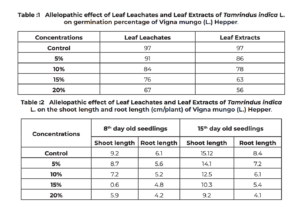
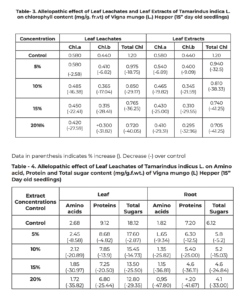
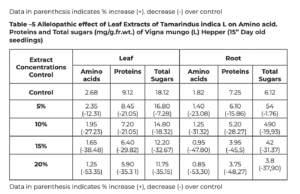
The acquired knowledge of allelopathy helps in
- Explaining vegetation patterns in plant communities.
- Understanding reduction in crop yields to adaptation of minimum tillage and use of stubble mulch of crop residues.
- Breeding crop plants will inhibit the weeds through allelopathic action, thus reducing the need for chemical weed killers.
- Afforestation.
- Understanding several ecological phenomena such as succession patterning of vegetation etc.,
Allelopathy is an area where research studies have shown that allelopathy could be utilised, for the following,
- To increase the production of food grains, vegetables, fruits and forestry
- To decrease harmful effects of modern agricultural practices on soil health and productivity
- To maintain soil productivity and pollution free environment for our future generations.
Allelopathy is ecologically important because it influences dominance. productivity. succession. Species diversity, composition of plant communities and vegetation dynamics.
Conclusion
The study clearly showed the Allelopathic potential of leaf leachates on the germination and growth parameters black gram (Vigna mungo.(L.) Hepper. From the investigation the Leaf Extracts of Tamrindus indica L. had more adverse effect on the germination, growth of Black gram seedlings than the Leaf Leachates.
References
Al- Mousawi, A.H. and Al Naib. F.A.G. 1976 Volatile growth inhibitors produced by Eucalyptus microtheca. Bull. Boil Res. Centre, 7:17-23
Al -Naib, FA. and Al -Mousawi, AH. 1976. Allelopathic effects have Eucalyptus microtheca, identification and characterization on the phenolic compounds in Eucalyplus miorotheca J. Univ Kuwait Sci. 3.83-83
AL-Mezon, HA. A-Saadawi, 1.5. and Al-Hadithi, TR, 1999 Allelopathic effects of corn residues on the subsequent corn crops Alelopallhy Journal, 6: 193-200
Anaya A.L. Pelayo Benavdes H.R, 1997 Allelopathic effect of Mirabilis Jalapa. L. on germination, growth of Wheat, Maize, Peas Allelopathy Journal, 1997, 4:1. 57-68
Anurag Saxena and Sharma, AK, 1996. Allelopathic potential of Acacia tortilis in agroforestry systems of arid regions. Allelopatihy Journal 3(1): 81-84
Arnon. D., 1949. Copper enzymes in isolated chloroplast Polyphenol Oxidize in Beta vulgaris. J. Plant physiol, 24; 1-15
Azania, A.AP.M., Azania, C.A.M.. Alves. PL.C.A, Palaniraj, R Kadian.H.S. Sali,S.C. RawatLS. Dahia D.S. and Narwal S.S. 2003 Allelopathic Plants-Sunfiower (Helianthus auunns L.). Allelopathy Journal 11:1-20
Balasubramanian, A and Ravichandran, VK 1996 Allelopathic significance of six agroforestry trees on Casuarina equsetilolia growth and nodulation. Madras agricullonal journal. 83; 84-87
Nelson, N. 1944 A photometric adaptation of the Somogyi’s method for the determination of reducing sugar Anal Chem 31: 426-428.
Newman and Rovira, AD. 1975. Allelopathy among some grassland species. J. Ecol, 63: 727-737
Oudhia, P. Kolhe, S.S. and Tripathi, R.S. 1995. Allelopathic effect of Ageratum conyzoldes L. on germination of linseed var. Kiran. Weed News. 2(1): 15- 18.
Oudhia, P Kolhe, S.S. and Tripathi.R.S.. 1997. Allepathic effect of Blumia lacera L on wheat. Indian J. weed Sci., 29:4-7.
Padhy. B, Patnaik, P. Kand Tnipathy. A.K. 2000. Allelopathic potential of Euof Eucalyptuslitter leachtes on germination and seedling growth of fingermillet. Allelopathy J.,7(11. 69-78.
Pandya, S.M., and Sidha, V. K, 1987.Competition between Celosia argentea Linn.and sorghum with reference to the weed position. J. Indian Bot. Soc., 66 16-21
Parvez, S.S., Parvez, M.M, Yoshiharu, Fuji, H. G, 2004 Differential allelopthic expression of bark and seed of Tamarindus indica L. P growth regulation, 42(3): 245-253.
Patterson. G.ML Harris, D. and cohen, W.S., 1979. Inhibition of photosynthetic and mito cnondra electron transport by a toxic substance isolated from the alga Pondorina morum, Plant Sci Leit. 15:293-300.
Sugha. S Kashal RP and Dua., 1S. 1980. Effects of certain aqueous leaf extracts on the germination and seeding growth of maize (Zea mays L) Science and Culture, 46 (5). 196-199
Suseeianma, M.and Venkata raju, R.P 1994 Effect of Digera muncata L) Mart. extracts on the germination and seeding grow of groundnut Allelopathy Journal, 1:53-57
Tamer, RS, Gesto, M.D.V. and Vieitez, E, 1973. Growth substances isolated from tubers of Cyperus esculentus var. accureus. Physiol Plant, 28: 195-200.
Tiwan, J.P Kurchani, S.P., Bhalla, C.S. and Paradkar, N.R. 1998 Studies on an allelopathic effects of Cassia tora on Parthenium hysterophorus. Indian J. Weed Sci, 30: 204- 205.
Tripathi, S., Tripathi, A., Kori, D.C. and Tiwari, S. 1998.Effect of tree germination and seedlings growth of leaves aqueous extracts soybean. Allelopathy Joumal.5 (1): 75-82.
Tukey. H.B. Jr. 1969. Implication ot allelopathy in agricultural plant science Rev. (Lancaster) 35;1-16.
Wardle, D.A. Nicholson, K.S. and Ahmed. M., 1992. Comparison of osmotic and allelopathic etfects of grass leaf extracts on grass seed germination and radicle elongation. Plant and soil. 140, 315- 319
Weaks. C., 1936. The influence of extract form Robina pseudoacacia on the growth of barley. Publ. FaC, Univ Charics. Prague, 150, 84-85
Weaver. T.W. and Klarich, D. 1977., Allelopathic. effects of Volatile substances from Artimisia tridentate Nutt. American midland Naturalist, 97:508-512.


